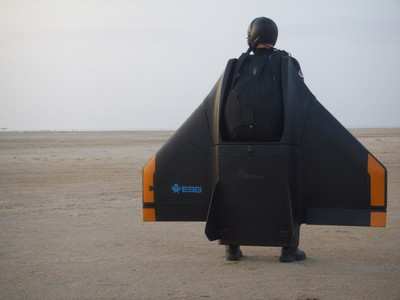Sun, May 04, 2008
Can Travel 125 Miles From 30,000 Feet... At 135 MPH
Don't confuse the next item with the opening of the film "Iron
Man" this weekend -- this is the real deal. It may not outrun a
Raptor... but its agility and stealth could revolutionize skydiving
as a sport, and eventually see its way to combat.

The Gryphon attack glider designed by SPELCO GbR weighs only 30
pounds and has a 6-foot swept-wing that is steered with handheld
rotary controls connected to its rudder. It can be fully weaponized
for assault and hide more than 100 pounds of combat gear in a
built-in compartment.
Designed to penetrate combat zones at 135 miles per hour, the
Gryphon is maneuverable enough to fly through the legs of Paris'
Eiffel Tower at high speed, as demonstrated through a simulation to
FOX News recently. The wing separates from the pack before the
parachute is deployed and remains connected via a cord, allowing it
to land before the pilot.
SPELCO hopes to offer the Gryphon to armed forces as a solution
to high altitude, high opening (HAHO) missions. Currently such
missions require jumps close to combat zones since traditional
parachutes only travel around 30 miles from the drop point to the
landing zone.
Future plans by SPELCO for the Gryphon include incorporation of
a small turbojet like those used for Unmanned Aerial Vehicle (UAV)
propulsion. Such an addition would eliminate the need to exit at a
high altitude to cover large distances... or, give soldiers added
time, and distance.
With its 5.1 glide ratio and on-board oxygen
system, a jet-powered Gryphon could allow soldiers to
exit up to 125 miles away from the landing zone at an altitude of
30,000 feet, far away from high-risk combat zones. The speed of the
Gryphon reduces the time of descent to from the typical 45 minutes
of a current HAHO mission to only 15 minutes -- significantly
reducing exposure to extreme cold at altitude, and possibility of
detection.

The compact design of the Gryphon with all equipment contained
within the lifting body gives the unit a very small radar
signature, making it an obvious choice for stealth missions.
More News
Airport Marking Aids Markings used on runway and taxiway surfaces to identify a specific runway, a runway threshold, a centerline, a hold line, etc. A runway should be marked in ac>[...]
"It is extremely difficult, if not impossible, for manned aircraft to see a drone while conducting crop-enhancing and other aerial applications at low altitudes and high speeds. We>[...]
Aero Linx: The Skyhawk Association The Skyhawk Association is a non-profit organization founded by former Skyhawk Pilots which is open to anyone with an affinity for the A-4 Skyhaw>[...]
“The T-54A benefits from an active Beechcraft King Air assembly line in Wichita, Kansas, where all required METS avionics and interior modifications are installed on the line>[...]
Aero Linx: Aerostar Owners Association The Association offers the Aerostar Owner a unique opportunity to tap an invaluable source of information concerning the care and feeding of >[...]
 ANN's Daily Aero-Term (04.28.24): Airport Marking Aids
ANN's Daily Aero-Term (04.28.24): Airport Marking Aids Aero-News: Quote of the Day (04.28.24)
Aero-News: Quote of the Day (04.28.24) ANN's Daily Aero-Linx (04.28.24)
ANN's Daily Aero-Linx (04.28.24) Aero-News: Quote of the Day (04.29.24)
Aero-News: Quote of the Day (04.29.24) ANN's Daily Aero-Linx (04.29.24)
ANN's Daily Aero-Linx (04.29.24)




